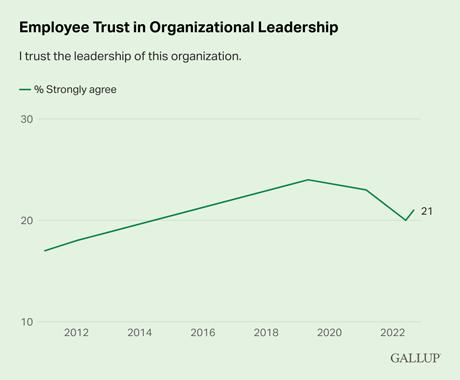Story Highlights
- Quiet firing is a form of neglect that slowly pushes employees out of their job
- Withholding coaching, development and recognition is a fast way to quiet fire
- Quiet firing is never a good way to avoid a hard conversation -- try these solutions instead
Managers and leaders, you have probably heard about quiet quitting, but are you guilty of quiet firing?
Quiet quitting describes the psychological withdrawal of an employee from their organization, resulting from not being engaged at work or having a poor work-life balance. The employee does not actually leave the organization, but they're no longer giving their best efforts.
Quiet firing describes how managers fail to adequately provide coaching, support and career development to an employee, which results in pushing the employee out of an organization.
In a worst-case scenario, quiet firing happens when managers allow employees to have truly toxic or miserable experiences at work as a way to squeeze them out. It's a form of gaslighting.
And while this may be a common practice in today's workplace, it isn't good leadership, productive or the right thing to do. At the very least, it tarnishes your employer's reputation as a good place to work, poisons team trust and can even hurt your ability to keep customers happy when key employees exit.
But perhaps the most pervasive problem in today's workplace is nice, well-intentioned people who are absent managers.
Without meaning to, many managers are quiet firing their team members by not helping them perform, develop and feel appreciated for their contributions.
These managers are not actively toxic or directly hurtful. They may even care deeply about their employees. But they are more absent than present, more distracted by organizational politics than engaged in building up their team and more inconsistent than consistent with their expectations. When employees don't get direction -- on their work priorities, ongoing development and long-term career progression -- they are on their way to quitting.
Quiet firing describes how managers fail to adequately provide coaching, support and career development to an employee, which results in pushing the employee out of an organization.
Based on Gallup's workplace science and experience developing great managers, we have found three serious mistakes that often led to quiet firing team members:
How Managers Quietly Fire People -- and Then Watch Them Quit
Mistake No. 1: Managers don't routinely discuss goal progress and give performance feedback.
- Globally, only 1 in 3 employees strongly agree that someone has talked to them about their progress in the past six months.
- By doubling that ratio, Gallup's partner organizations have achieved 28% lower absenteeism and 10% higher productivity, on average.
- When employees receive meaningful feedback at least weekly, they are nearly half as likely to be watching for a new job.
What goes wrong:
People need to know what's expected of them at work and how they are progressing. Routinely setting the right goals, adjusting them as needed and achieving the desired results is the foundation of an effective performance management strategy. Without this natural rhythm of work, employees quickly lose their ability to focus their efforts. And they won't have a firm understanding of what their manager thinks of their performance or the requirements of their role.
At the height of the pandemic, many organizations stopped requiring employees to set goals or stay accountable to them. This should have been a sign that important management practices were slipping and employee engagement was in danger. Goals were being set so haphazardly and infrequently that they didn't feel relevant in a greatly disrupted and continually changing marketplace. When goals don't feel important or meaningful -- or simply don't get revisited more than once a year -- employees check out.
On top of that, when managers fail to have frequent, meaningful conversations about their progress, it leaves employees wondering how they're doing. They miss important opportunities to celebrate successes, adjust priorities and provide the support needed to help employees succeed.
Often managers don't even realize they're doing a bad job clarifying expectations and priorities. Only 22% of employees strongly agree that their manager continually helps them clarify work priorities, whereas nearly twice as many managers (43%) believe that they are actively helping employees set priorities.
What to do about it:
Have you recently had a meaningful conversation with each of your employees in the past week?
Employees who have at least one meaningful conversation each week with their manager are nearly four times as likely to be engaged at work.
Not all conversations have to be about performance goals. Just talking to team members about their current priorities and providing ongoing coaching creates great ways to connect daily efforts with their goals.
During these conversations, help employees create clear goals and make sure they understand that you fully support them in achieving these objectives. For instance, show you care by ensuring they have the proper resources and partnerships to reach their immediate goals.
This is also a great time to help them think about how to use their strengths to do their best work.
Create shared accountability:
Do you actively involve employees in setting their goals?
Goals are more meaningful when you involve employees in setting them. When employees feel they have a say in their own goals, they are more likely to internally commit to them. They are making a promise to themselves to embrace an ambitious but achievable outcome.
Often employees set even more difficult and extensive goals than their manager had in mind.
Mistake No. 2: Managers withhold development.
- Only 37% of managers strongly agree that they invest in their employees' development, and even fewer employees (25%) strongly agree that their manager invests in their professional development.
- The percentage of hybrid and fully remote workers younger than 35 who strongly agree that someone encourages their development at work has dropped by 12 points from 2019 to 2022.
What goes wrong:
In uncertain times, it's natural to pull back from talking about the future. Who knows what the marketplace holds for the next six months, let alone the next few years? But Gallup research has consistently shown that how you feel about your professional development and future in an organization greatly influences your likelihood of staying.
Employees who have at least one meaningful conversation each week with their manager are nearly 4 times as likely to be engaged at work.
The challenge is that employees often expect managers to provide a perfect road map for their careers, while managers expect employees to tell them exactly what they want to do in the future. It gets even trickier when trying to align employees' capabilities and experiences with the potential opportunities available to them.
What to do about it:
Does each employee have an individualized development plan and a career path?
Everyone needs a plan for development and advancement that's individualized to them. Start by getting a feel for employees' aspirations and strengths. From there, you can more constructively discuss what developmental options will help employees excel in their job today based on their goals and what future growth opportunities will help them progress in their careers.
Create shared accountability:
What commitments are employees making, and who takes ownership of them?
It's not about presenting promotions on a golden platter. Employees need a career path they can take ownership of through hard work and accountability. Managers need to be honest about the performance necessary to truly be successful, allowing employees to choose their own path freely.
Mistake No. 3: Managers don't give enough individualized recognition.
- Only 34% of employees strongly agree that their manager gives them recognition when they do good work.
- Conversely, 6 in 10 managers believe they do a good job of recognizing their direct reports when they do good work.
- When employees strongly agree that they have received recognition or praise in the past week, they are 39% less likely to be looking for a different job and 47% less likely to be burned out at work.
What goes wrong:
Timely recognition is easy to miss or forget about. Many organizations likely rely too heavily on events and traditions: awards, certificates and ceremonies. Annual or quarterly recognition often happens long after people have forgotten what they have done. While these events can be important to creating a culture of recognition, they are not the best psychological motivator for daily performance. Recognition events also tend to leave out a lot of people or don't feel individualized.
Timely recognition is easy to miss or forget about.
Unfortunately, only 10% of employees have been asked how they want to be recognized for their accomplishments. And often, managers struggle with even knowing that recent achievements or special efforts took place.
What to do about it:
How do your team members like to receive recognition?
The most powerful recognition is timely, specific, and authentic. Much of the praise you give employees can happen during those weekly meaningful conversations previously recommended and during more formal discussions about goal progress.
Outside of meeting with employees, look for opportunities to send thank you notes and include their teammates in recognition emails. Don't underestimate the value of a thank you, high five or congratulatory comments in the hallway.
Naturally, when employees are struggling, it can be hard to find things to praise. But this is a great time for managers to identify smaller wins -- and even give informal recognition -- to lead employees back to high performance.
Create shared accountability:
How is everyone creating a culture of recognition?
Team meetings provide a great opportunity to both recognize individuals in front of their peers and ask teammates to offer appreciation for recent contributions. Managers can't see or hear everything; often, peers give the most meaningful recognition. When employees start routinely recognizing each other outside of scheduled meetings or events, you know you have an authentic culture of recognition.
When Keeping an Employee on Your Team Causes More Harm Than Good
Quiet firing an employee may seem like a convenient way to avoid a hard conversation, but ultimately, it affects team morale. The quiet quitter being quiet fired becomes a silent example of what's acceptable from both the employee and manager. When the rest of the team watches quiet quitters give up on their work and managers give up on team members, people start to lose confidence in their team.
Quiet firing creates a negative team environment -- maybe even a secret, unspoken subtext for team meetings and projects that erodes trust and team effectiveness. This is a failure of the manager. It's the manager's responsibility to have open, candid two-way conversations with their team members so that everyone feels like they can speak honestly about roadblocks to performance. Goals, development and recognition only work together cohesively once managers establish this rapport.
Quiet firing an employee may seem like a convenient way to avoid a hard conversation, but ultimately, it affects team morale.
But what happens once you have done these things?
If you have genuinely and diligently had ongoing conversations with an employee about their goals, gave performance feedback and provided development planning, but they still aren't meeting expectations, it might be time to part ways.
If you've included them in setting their goals, it should be clear why they aren't meeting expectations. By providing support -- helping them understand their strengths, clarifying their career goals and recognizing where they shine -- managers can develop employees even as they let them go.
Ultimately, managers must do what is best for their team. Holding on to low-performing employees for any reason besides coaching and developing them to the needed level of performance is a disservice to the rest of the team.
However, before you make a decision, stop and check yourself -- and get input from others.
The reality is most managers are likely withdrawing their support and effort too soon in the process. The best test is whether your team believes they are getting enough support to take full ownership of their performance and development.
One Last Warning for Leaders: When Your Managers Quiet Quit, They Quiet Fire Their Team
Some managers are ready to change their habits. They just need a little training and occasional reminders to be more intentional about having frequent, consistent conversations that cut to the heart of getting work done and helping team members progress in their careers.
Unfortunately, too often, managers are less engaged than their team members. In fact, Gallup recently also found that managers were feeling more burned out at work than the individual contributors they lead. Instead of these team leaders lifting up their followers, their followers are finding ways to succeed despite working for managers struggling to balance their own responsibilities.
The world of work will not be getting easier for managers any time soon. For many, being a manager has already been further complicated by the workforce's unprecedented shift to remote and hybrid work. Many managers are learning how to lead remote and hybrid work teams for the first time, and few are receiving the training they need. These managers need more support than ever going forward.
This is where executive leadership needs to step in. If your managers are quiet quitting -- disengaging from their roles -- the effects spread to their team and the whole organization. When your managers are not helping employees progress in their jobs, they're escorting them out of the organization.
Not quite ready to extinguish quiet firing at your organization? Let Gallup help with its science-backed management strategies, tools and training.
- Learn more about how quiet quitting and quiet firing connect to employee engagement.
- Learn how to engage your employees and facilitate ongoing, developmental conversations.
- Bring employee engagement to your workplace. We'll help you do it your way.





